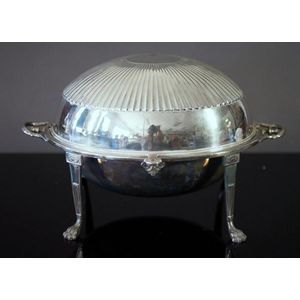Edwardian Silver Plated Mechanical Cover Warming Dish
You must be a subscriber, and be logged in to view price and dealer details.
Subscribe Now to view actual auction price for this item
When you subscribe, you have the option of setting the currency in which to display prices to $Au, $US, $NZ or Stg.
- Oviform /ovoid - The outline loosely resembling the shape of an egg.
- Edwardian - The Edwardian period of English furniture and decorative arts design is named for Edward VII (1841 ? 1910) who was King of the United Kingdom and the British Dominions and Emperor of India for the brief period from 1901 until his death in 1910. It follows the Victorian period, in turn was followed by the Art Nouveau and Art Deco styles. In Australia, designs of this period are also known as being in the Federation style.
- Lion's Paw - The decorative lion's paw has been used in furniture, silver, and ceramics for centuries. It is a stylized representation of the paw of a lion, often depicted in a highly realistic or stylized form.
In furniture design, lion's paws were popular in the neoclassical and Empire styles of the late 18th and early 19th centuries. They were often used as feet on tables, chairs, and other pieces of furniture. The lion's paw was a popular motif for furniture makers because it added a sense of grandeur and regalness to their pieces.
In silverware design, the lion's paw was often used on the feet of tea and coffee pots, as well as on other pieces of silverware such as wine coolers and tureens. The lion's paw was often used in combination with other neoclassical motifs, such as acanthus leaves or grape clusters, to create a sense of grandeur and classical elegance.
In ceramics, lion's paws were commonly used as feet on vases, urns, and other pottery items. The lion's paw was often depicted in relief or as a highly stylized form, and was sometimes used in combination with other decorative elements, such as garlands or swags.
This item has been included into following indexes:
Visually similar items

Silver plated soup tureen, with dome shaped lid, by James Dixon, Sheffield, 36 cm wide approx

A fine antique silver plated Chafing dish, early 20th century, with mark and 'All the round' symbol of John round & Son, the oval dish with a hinged lid, having two internal dishes, one pierced, and raised on striking tapering flat ribbed legs with hairy p

Silver plated covered dish. Retractable reeded design lid, quad footed, with internal plates. Estate late Douglas Osborne Hawke. Diameter 34 cm

A Sheffield plate food warmer, by John round & Son, mid to late 19th century, oval domed warmer with bright cut floral and foliate sprays to the hinged roll lid and a continuous ribbon and fern pattern encircling, with fluted side handles and supported on
